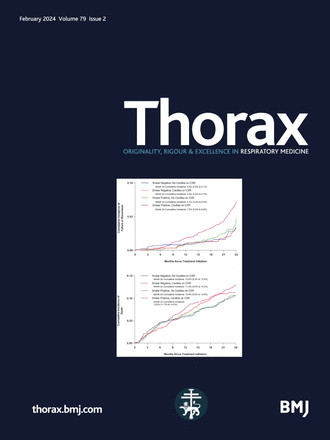胰高血糖素样肽-1 受体激动剂可能有益于慢性阻塞性肺病患者的心肺疗效
IF 9
1区 医学
Q1 RESPIRATORY SYSTEM
引用次数: 0
摘要
背景 临床研究表明,胰高血糖素样肽-1 受体激动剂(GLP-1 RA)可对心肺功能产生有益影响。我们进行了这项纵向队列研究,以比较 2 型糖尿病(T2D)和慢性阻塞性肺病(COPD)患者使用和不使用 GLP-1 RA 的心肺功能风险和死亡率。方法 该研究从2008年1月1日至2019年12月31日期间的台湾国民健康保险研究数据库中确定了8060名匹配的GLP-1 RA使用者和非使用者。采用Cox比例危害模型确定GLP-1 RA使用者和非使用者之间的心肺结局风险。结果 GLP-1 RA使用者和非使用者的平均随访时间分别为2.51年和2.46年。在匹配队列中,GLP-1 RA 使用者的死亡率(调整 HR (aHR) 0.46,95% CI 0.38 至 0.56)、心血管事件(aHR 0.73,95% CI 0.65 至 0.82)、无创正压通气(aHR 0.66,95% CI 0.47 至 0.93)、有创机械通气(aHR 0.64,95% CI 0.51 至 0.8)和细菌性肺炎(aHR 0.76,95% CI 0.65 至 0.88)。随后对不同亚组和用药时间的分析也显示,GLP-1 RA 与死亡率、心血管事件、通气支持和细菌性肺炎的相关风险显著低于非 GLP-1 RA。结论 这项全国性队列研究表明,与非 GLP-1 RA 相比,GLP-1 RA 可降低 T2D 和慢性阻塞性肺病患者的心肺预后风险和全因死亡率。GLP-1 RA 可帮助慢性阻塞性肺病患者控制糖尿病。暂无数据。本研究的数据来自台湾国民健康保险管理局(NHI)发布的国民健康保险研究数据库(NHIRD)。由于台湾政府自 2012 年起实施 "个人信息保护法",本研究中使用的数据无法在论文、补充文件或公共资料库中提供。如需索取数据,可向国家健康保险研究所办公室()提出正式申请,或发送电子邮件至 stsung@mohw.gov.tw。本文章由计算机程序翻译,如有差异,请以英文原文为准。
Glucagon-like peptide-1 receptor agonists may benefit cardiopulmonary outcomes in patients with COPD
Background Clinical studies have shown that glucagon-like peptide-1 receptor agonists (GLP-1 RA) can have beneficial effects on cardiopulmonary function. We conducted this longitudinal cohort study to compare the risk of cardiopulmonary outcomes and mortality between GLP-1 RA use and no use in patients with type 2 diabetes (T2D) and chronic obstructive pulmonary disease (COPD). Methods The study identified 8060 matched GLP-1 RA users and non-users from Taiwan’s National Health Insurance Research Database from 1 January 2008 to 31 December 2019. Cox proportional hazards models were used to determine the risk of cardiopulmonary outcomes between GLP-1 RA users and non-users. Results The mean follow-up time was 2.51 and 2.46 years for GLP-1 RA users and non-users, respectively. In the matched cohorts, GLP-1 RA users had a significantly lower risk of mortality (adjusted HR (aHR) 0.46, 95% CI 0.38 to 0.56), cardiovascular events (aHR 0.73, 95% CI 0.65 to 0.82), non-invasive positive pressure ventilation (aHR 0.66, 95% CI 0.47 to 0.93), invasive mechanical ventilation (aHR 0.64, 95% CI 0.51 to 0.8) and bacterial pneumonia (aHR 0.76, 95% CI 0.65 to 0.88) than GLP-1 RA non-users. The subsequent analyses for various subgroup and medication duration also showed that GLP-1 RA was associated with a significantly lower risk of mortality, cardiovascular events, ventilation support and bacterial pneumonia than non-GLP-1 RA. Conclusion This nationwide cohort study showed that GLP-1 RA had a lower risk of cardiopulmonary outcomes and all-cause mortality than non-GLP-1 RA in patients with T2D and COPD. GLP-1 RA may help manage diabetes in people with COPD. No data are available. Data of this study are available from the National Health Insurance Research Database (NHIRD) published by Taiwan National Health Insurance (NHI) Administration. The data used in this study cannot be made available in the paper, the supplemental files or in a public repository due to the ‘Personal Information Protection Act’ executed by Taiwan government starting from 2012. Requests for data can be sent as a formal proposal to the NHIRD office () or by email to stsung@mohw.gov.tw.
求助全文
通过发布文献求助,成功后即可免费获取论文全文。
去求助
来源期刊

Thorax
医学-呼吸系统
CiteScore
16.10
自引率
2.00%
发文量
197
审稿时长
1 months
期刊介绍:
Thorax stands as one of the premier respiratory medicine journals globally, featuring clinical and experimental research articles spanning respiratory medicine, pediatrics, immunology, pharmacology, pathology, and surgery. The journal's mission is to publish noteworthy advancements in scientific understanding that are poised to influence clinical practice significantly. This encompasses articles delving into basic and translational mechanisms applicable to clinical material, covering areas such as cell and molecular biology, genetics, epidemiology, and immunology.
 求助内容:
求助内容: 应助结果提醒方式:
应助结果提醒方式:


